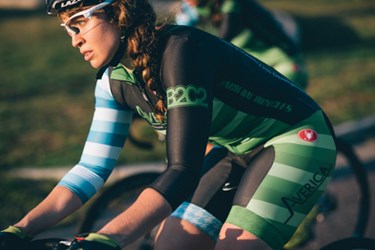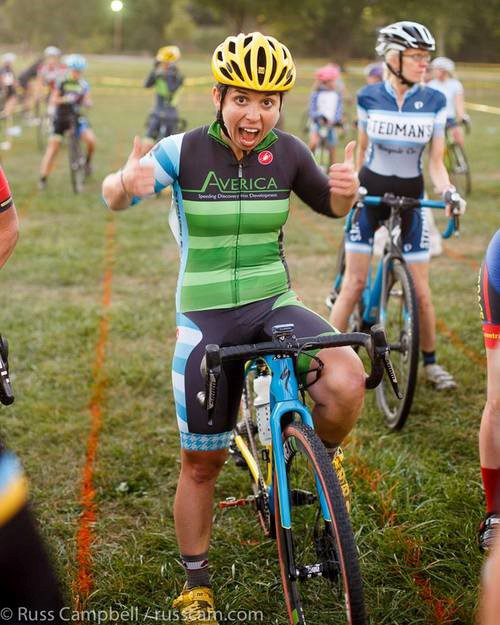The Impact Of A Cycling Team: An Inbound Marketing Case Study

By Jeffrey P. Kiplinger, Ph.D., founder, Averica Discovery
Averica Discovery is a specialty contract research organization (CRO) established in 2007 in the Boston area. We’re an analytics company focused on supporting preclinical and clinical development programs. Like most such firms, we invested first in our own lab and science, hiring skills and buying technology to create a vital and viable company. Our customers came from our network and local area. Our sales approach was direct, face-to-face, and our brand awareness grew organically and gradually over time.
We made a decision in 2014 to expand our operation and market aggressively. For the first time, we decided to invest in “inbound marketing,” the art of helping potential customers find us. Inbound marketing recognizes that today’s consumers search for a provider instead of the vendor pitching to customers. Think about how door-to-door sales changed to cold calling, and changed again – now everyone researches products and companies places orders directly online. Often, there’s no human interaction in the sale at all.
Inbound marketing requires potential customers find us – that’s about our website, search engine optimization (SEO) and content. But finding us is only part of it. Engagement from an inbound potential customer requires that they find us, recognize us, and associate us with a quality they want or need. They need to find us and like us. That’s about reputation and visibility – key aspects of a good branding program. Louis Garguilo’s recent article on the importance of reputation prompted me to share our story with OutsourcedPharma.com readers.
Like many, we constantly experiment with marketing: playing with a mix of technical content (presentations and downloads), website fine-tuning, social media, and blast emailing. A variety of analytical tools precisely track customer engagement results. Of course there’s been a learning curve, but it’s been worth the effort.

In the olden days (5-10 years ago), we might have relied on print ads or trade show booths, each a marketing investment costing thousands of dollars. These costs are not only high, but their effectiveness is in flux. Attendance at many of the long-standing trade shows has dropped by as much as 75% in the past 10 years.
Last year (2015) we decided to try something new and experimental – sponsoring an elite level women’s cyclocross team. Team Averica launched in early summer of 2015, and our first racing season wrapped up with the US Cyclocross National Championships – “CrossNats” this January in Asheville, NC.
Cyclocross is a fast-growing bicycle racing discipline that is crowd-friendly, increasingly popular among kids and junior racers, and gaining media coverage. Unlike other cycling disciplines, notably road cycling (think: Tour de France), media coverage of elite women is nearly as deep as elite men. Cross has a high “cool factor.” The sport doesn’t have a high entry price. And our biggest national markets for pharma clients, Boston and California, are loaded with cyclists.
The big question: “How can we gauge the impact of our investment in this somewhat unusual marketing buy?”
Analysis
Companies sponsoring cycling teams have generally thought of their investments as “rolling billboards.” Particularly for the road racing disciplines, cyclists would wear their logo-covered jerseys and shorts in training and commuting as well as while racing. In theory this increases the likelihood that customers – even those not interested in biking – would recognize the logo when seeing it in another context. Marketing people speak of “touches” –the tiny, maybe even subliminal, engagements of your brand with your potential customer.
At Averica, we tried to look at the exposure with a broader view. The audience for local races is growing but limited to real fans, the web exposure of the team is largely within the cycling community, and even CrossNats gets an online audience of tens of thousands. Hearing “Here comes ______ of Team Averica!” from one of the announcers is great, but will it bring in a new client?
Possibly. But the true value in our sponsorship comes from three contributions to our branding effort:
Representing a corporate attitude and personality. Let’s face it, a science company can seem serious, and scientists - well, a little geeky. What if Averica were about more than just our lab skills?
Team Averica – that’s the cycling team, not our lab crew - and Back Bay Cycling Club proposed a program that includes outreach to beginning and young cyclists, supporting the development of three racers on the edge of a breakthrough, and involvement with a sport with a rising profile. So our involvement is more than advertising, and our company is about more than ourselves.
There’s an ethical component too: women’s sports are often underfunded when compared to men’s. We wanted to put some money and effort where it would have the most impact. It makes a difference to us that we’re helping to even a playing field. These are essentially personal reasons for our sponsorship, but as such they reflect our personality. By showing the world more than just our mad lab skills, we round out our image and say something about our philosophy.
Representing a corporate image. Our company branding highlights our speed, teamwork, and agility. Bicycle technology and engineering makes racing machines as intricate and cutting edge as a new HPLC system. Scientists work hard – train hard – to get ahead in a tough field. So we use these positive, aligned characteristics to reinforce our self-image and our brand. Similarly, Amgen, Omega Pharma, United Healthcare, and other life sciences corporations are big sponsors of cycling.
The “cool factor.” If media have successfully branded the Tour de France as the hardest sporting event on the planet, cyclocross is more “hard, fast, crazy, and fun.” Colors are brighter, tattoos more visible, and events more… different? We’re a lab company. We sometimes need a little cool factor.
And yes, Team Averica races in very colorful Lycra skinsuits that display our logo and colors. The design is eye-catching and hard to miss. We have a branded, bright green tent at the races. We look great.
We’ve also noticed that women’s bike racing has a personality distinct from men’s. There’s a tangible camaraderie, a lot of smiling and laughing, and emotion combined with the race intensity. There’s community. There’s a lot of fun coupled with the toughness of racing. We can bring in a little of that personality with the pictures we use on our website and in presentations. In a small but significant way, we can bring a little of the Team Averica attitude to the way we think about ourselves.
So how can we analyze the impact of our spend on our brand and visibility? The answer is “indirectly.”
First, we see upticks in activity on social media when we directly engage our followers with specific news about the cycling team. Tweets are retweeted, views of LinkedIn posts tick up. Pictures and videos have higher rates of engagement on social media, and we are able to use lots of exciting shots of our racers in their Team Averica gear. Because most of our social media followers are in life sciences companies, we know we’re catching the eyes of potential clients.
More significantly, our credibility and trust scores with Google have risen, contributing directly to our search engine positioning. Current approaches to searching are based on credibility, which comes from a mix of factors, but in general credibility goes up when Google can tell people are looking at you with some interest.
Second, we see a 5-8% recognition rate of the program. Talking with a scientist/customer on the phone, it’s not uncommon to hear, “I saw the press release about the cycling team – great stuff!” or “I used to race bikes and I think it’s great you sponsor the cycling team.” With direct selling, we find it easier to establish a rapport with the person we’re meeting – again, it’s about having a personality that extends beyond “what we do” into “who we are.”
Last, our press releases about the team and our social media activity are heavily tracked within the cycling community. Averica gets attention as a local/regional sponsor and supporter of women’s cycling, resulting in followers from globally ranked cyclists, cycling media outlets, cycling teams and bicycle shops across the nation. With each social share, our reach spreads to cycling enthusiasts in our target pharma market.
Building a brand involves a gradual accumulation of impressions in the mind of the customer, and finding new sources of positive impressions and activities orthogonal to your industry. Our reputation, image, and personality are our brand; and that’s just as important for our success as our capabilities and differentiators.
# # # #
 Jeffrey P. Kiplinger, Ph.D. has nearly 30 years of experience in pharmaceutical and related industries, working extensively in the discovery and optimization of small molecule human and veterinary therapeutics. A respected scientist who has published more than 30 research papers and a frequent speaker at dozens of scientific conferences and meetings, Dr. Kiplinger founded Averica Discovery as a contract source of analytical development chromatography services to drug discovery and development teams.
Jeffrey P. Kiplinger, Ph.D. has nearly 30 years of experience in pharmaceutical and related industries, working extensively in the discovery and optimization of small molecule human and veterinary therapeutics. A respected scientist who has published more than 30 research papers and a frequent speaker at dozens of scientific conferences and meetings, Dr. Kiplinger founded Averica Discovery as a contract source of analytical development chromatography services to drug discovery and development teams.
